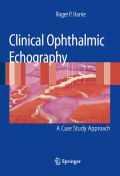
Ultrasonography is an important adjuvant for the clinical assessment of a variety of ocular and orbital diseases. With proper use, one can gather a vast amount of information not possible with physical exam alone. Ultrasound is most useful when intraocular are difficult or impossible to examine. Situations that prevent normal examination include lid problems (severe edema, partial or total tarsorrhaphy), keratoprosthesis, corneal opacities, hyphema, hypopyon, miosis, pupillary membranes, dense cataracts, or vitreous opacities (hemorrhage, inflammatory debris). Diagnostic B-scan ultrasound accurately images intraocular structures and give valuable information on the status of the lens, vitreous, retina, choroid, and sclera. Ultrasound is uniquely able to quickly and reliably diagnose certain eye disorders and this is the only practical manual on how to do so The case-based orientation and inexpensive paperback format are perfect for busy clinical settings The author is a well-recognized expert with practical, clinical experience in the field INDICE: Introduction to ocular and orbital ultrasound.- The role of ultrasound in imaging studies of the eye.- The evaluation of the painful eye.- The eye with opaque media.- Vitreo-retinal disease.- Ocular and orbital trauma.- Biometry.- Anterior segment problems.- Intraocular tumors.- Diplopia.- The swollen disc.- Vascular lesions.- Pitfalls and artifacts.- Ophthalmic ultrasound indeveloping countries.
- ISBN: 978-0-387-75243-3
- Editorial: Springer
- Encuadernacion: Rústica
- Páginas: 495
- Fecha Publicación: 01/11/2008
- Nº Volúmenes: 1
- Idioma: Inglés
